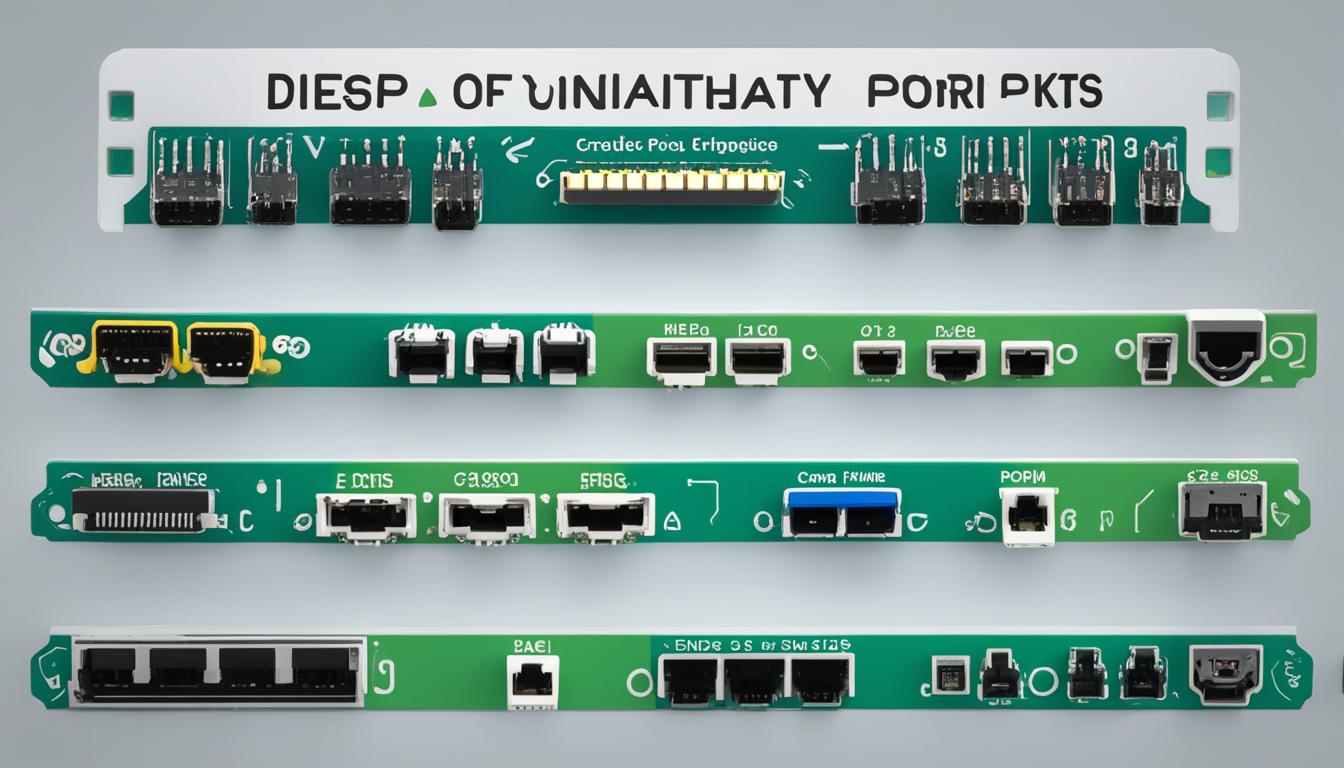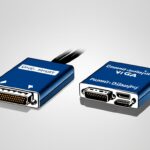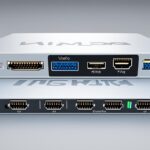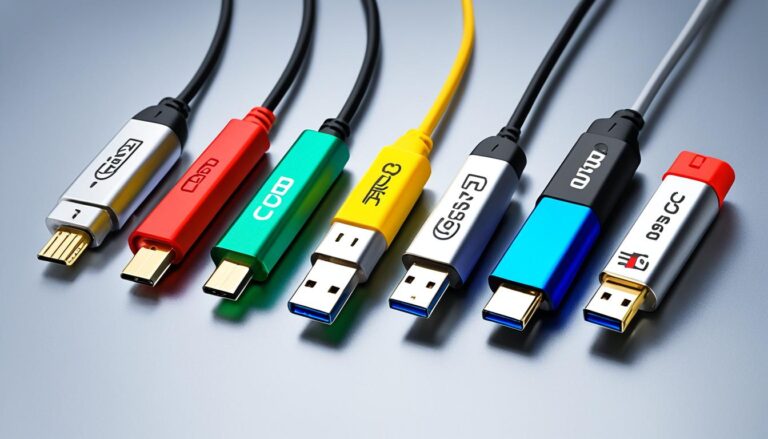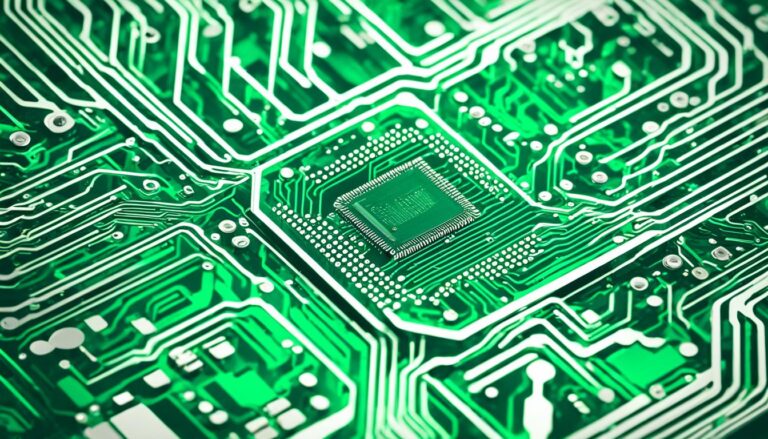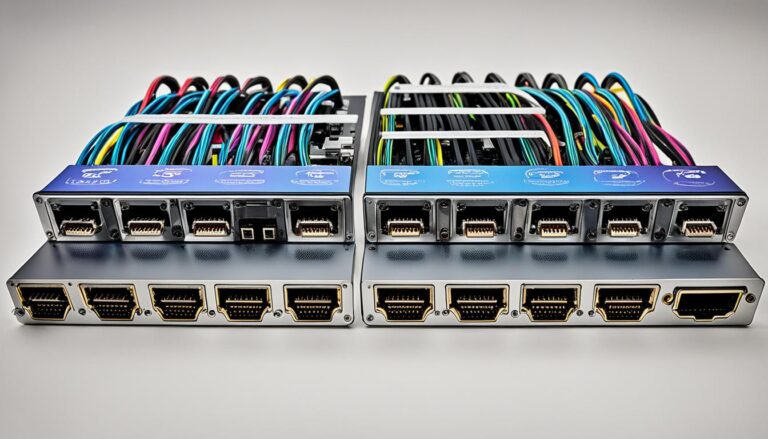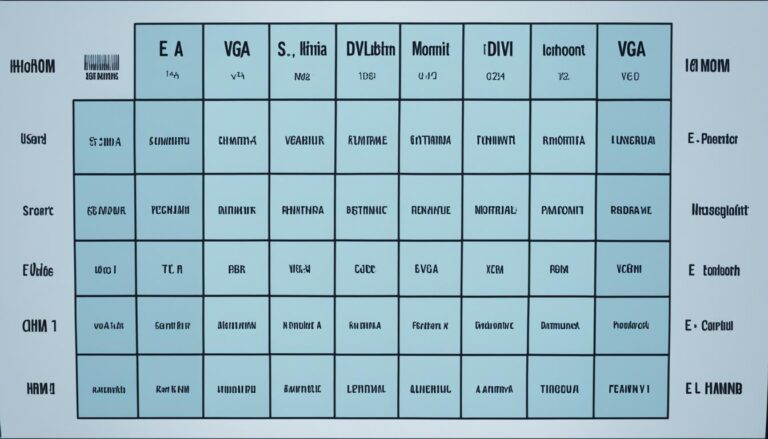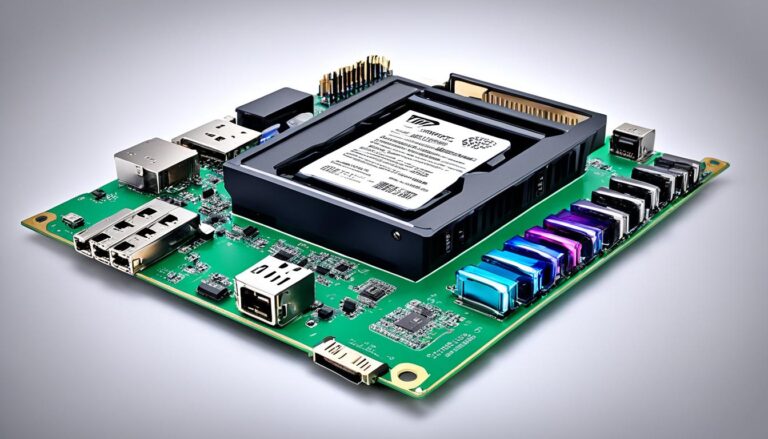Adding a bigger screen to your laptop or another monitor to your desktop boosts productivity. The most seen display connections are HDMI, DisplayPort, VGA, DVI, and USB-C. HDMI is popular for sending both video and audio, making it handy and flexible.
DisplayPort is great for higher quality pictures and colours, ideal for work tasks. VGA and DVI are older and less common now but might be on some gadgets. USB-C is getting more love for its do-it-all approach, carrying power, sound, and image in one cable.
HDMI: The Best TV to PC Connection
HDMI (High-Definition Multimedia Interface) is everywhere. You’ll find it in TVs, set-top boxes, tablets, laptops, and even game consoles. It’s brilliant for sending video and audio together, so everything looks and sounds clear. With different versions like HDMI 2.0, you get even better pictures, more colors, and smoother videos.
Using HDMI makes watching HD or UHD content a real treat. You get sharp, colorful images every time. Since it carries audio too, you only need one cable. This means less mess behind your TV or computer. HDMI is perfect for movies, streaming, gaming, or making your laptop screen bigger.
HDMI is great for both Macs and PCs. Yet, if you have an older device, you might need an adaptor. These adaptors make sure you can still use HDMI, no matter the port type your device has. This adds to HDMI’s flexibility and broad appeal.
HDMI is the top choice for connecting TVs to PCs. It’s easy to find, supports great picture and sound, and works with lots of devices. If you need a simple, high-quality way to link up your gadgets, HDMI is the way to go.
| HDMI Advantages | HDMI Disadvantages |
|---|---|
| Simplified one-cable solution | May require adapters for certain devices |
| Supports both audio and video transmission | May have limitations with long cable lengths |
| High definition and UHD resolution support | Less common on older devices |
| Widespread availability | N/A |
The Versatility of HDMI
“HDMI is a versatile and user-friendly interface that caters to the needs of multimedia enthusiasts. With its ability to transmit both audio and video signals in high definition, HDMI has revolutionized the way we connect our devices.”
– Stephanie Roberts, Tech Expert
HDMI is now the go-to for linking TVs, monitors, and other devices to PCs. It makes sure audio and video quality is top-notch. This means it’s the best pick for almost everyone. It works wonders for home theaters, games, or just making your laptop screen larger.
DisplayPort: 4K at 144Hz with Audio and Video Capabilities
DisplayPort is a digital display interface that brings top-notch visual quality. It also offers advanced features for audio and video. This interface supports amazing 4K resolutions and smooth visuals at 144Hz. It’s perfect for professionals, gamers, and anyone wanting high-performance display connections.
High-Quality Video Transmission
DisplayPort shines in sending high-quality video content. It beats other display ports like HDMI in resolutions, color depths, and refresh rates. The latest DisplayPort 1.4 even supports huge 8K resolutions. This brings a truly deep and immersive visual experience to your screen.
Optimal Performance for Gaming and Professional Use
For gaming and professional tasks, DisplayPort is a standout. It manages high-refresh rate monitors well. This means smooth motion and less blur in quick games. Also, its amazing color depth is great for photographers, video editors, and graphic designers. They get the precise colors they need for their work.
Advanced Audio Capabilities
But DisplayPort isn’t just about impressive video. It also offers advanced audio features. It sends high-quality audio signals well, ensuring a great audio-video experience. No extra cables needed. With DisplayPort, your impressive visuals are matched with immersive sound.
Comparing Key Features of DisplayPort, HDMI, and DVI
| Features | DisplayPort | HDMI | DVI |
|---|---|---|---|
| Maximum Resolution | Up to 8K | Up to 4K | Up to 2560 x 1600 |
| Refresh Rate | Up to 144Hz | Up to 60Hz | Up to 60Hz |
| Color Depth Support | 16-bit to 48-bit | 24-bit to 48-bit | 24-bit |
| Audio Transmission | Yes | Yes | No |
DVI: 144Hz at 1080p
DVI (Digital Visual Interface) connects video to monitors and projectors. It lets you see high-quality images with up to 2560 x 1600 resolution. For those who love games, DVI can give you a smooth and fun experience with its 144Hz refresh rate at 1080p.
DVI cables have types like DVI-D for digital and DVI-I for both analog and digital signals. This means you can choose based on what you need and what your device supports.
Many HDTVs and top-notch video displays have DVI. But, HDMI and DisplayPort are now more common. Still, DVI is great for anyone who wants fast refresh rates and clear pictures.
Benefits of DVI
- Supports resolutions up to 2560 x 1600
- Capable of achieving a refresh rate of 144Hz at 1080p
- Compatible with a wide range of monitors and projectors
- Offers reliable and stable video transmission
Drawbacks of DVI
- Does not support audio transmission, requiring a separate audio connection
- Not as widely adopted as HDMI and DisplayPort
- Limited to older devices and displays
While HDMI and DisplayPort are popular, DVI is still good for fast refresh rates and clear pictures. But, think about device compatibility and other connection options before choosing DVI.
| DVI | HDMI | DisplayPort |
|---|---|---|
| Max Resolution | 2560 x 1600 | 8K |
| Refresh Rate | Up to 144Hz at 1080p | Depends on version (e.g., DisplayPort 1.4 supports 240Hz at 1080p) |
| Audio Transmission | No (separate audio cable required) | Yes |
| Device Compatibility | Common on HDTVs and older displays | Widely adopted in modern devices |
VGA: A Legacy Cable Connection
VGA (Video Graphics Array) is an older type of connection for monitors. It connected video cards to computer monitors, handling RGBHV video signals. But, it could only manage analog signals. This means it didn’t support high resolutions as well as digital connections do.
Nowadays, you can still find VGA on some devices. It’s there for when you need to connect to older equipment. Even so, as time goes by, digital connections like HDMI and DisplayPort are taking over.
VGA might not give us the best picture quality nowadays. Yet, it was very important in the early days of computer graphics. It has made a significant mark on the history of how we see things on screens.
Table: Comparison of VGA with HDMI and DisplayPort
| VGA | HDMI | DisplayPort | |
|---|---|---|---|
| Signal Type | Analog | Digital | Digital |
| Maximum Resolution | Dependent on device, typically up to 1920×1200 | Dependent on version and device, up to 8K | Dependent on version and device, up to 8K |
| Audio Support | No | Yes | Yes |
| Common Applications | Legacy devices, older computers | TVs, monitors, gaming consoles, laptops | Monitors, professional graphics, gaming |
The table above shows the differences between VGA, HDMI, and DisplayPort. VGA lags behind in signal type, resolution, and audio support. Still, it can be useful for connecting with older devices.
USB-C: The All-in-One Connector
USB-C stands for Universal Serial Bus Type-C. It’s a versatile connector for power, audio, and video. Many devices like smartphones and laptops use it. It’s powerful and supports fast data transfer and charging.
Its design is reversible, making it easy to use. You don’t have to check which way to plug it in. This cuts down the need for many cables.
Power, Audio, and Video in One
USB-C combines power, audio, and video in one cable. It lets you connect to monitors or TVs easily. This helps keep your space tidy and free of extra cables.
It also works with HDMI, DisplayPort, and more. It’s perfect for connecting to projectors, streaming video, or moving data between devices. It meets a wide range of needs with ease.
USB-C offers a smooth experience for users. It’s versatile, delivers power efficiently, and works with many devices. It’s a top choice for anyone needing an easy solution for connecting their gadgets.
USB-C is ahead in multimedia connectivity. It merges power, audio, and video in one. This offers convenience and meets various needs with one connector.
| Feature | USB-C | HDMI | DisplayPort | DVI | VGA |
|---|---|---|---|---|---|
| Power Delivery | ✓ | – | – | – | – |
| Audio Transmission | ✓ | ✓ | ✓ | – | – |
| Video Transmission | ✓ | ✓ | ✓ | ✓ | ✓ |
| Reversible Design | ✓ | – | – | – | – |
| Data Transfer Speed | High | – | – | – | – |
Conclusion
In conclusion, choosing the right display port depends on what you need and like. HDMI is the most common choice. It sends both video and sound digitally.
DisplayPort is great for professionals who need clear pictures and fast refresh rates. DVI and VGA are older types but you might still see them on some devices.
However, they’re giving way to digital options. USB-C is gaining fame for its ability to do multiple jobs with one cable. Think about what you need and if your devices are compatible before making a choice.
FAQ
What are the different display ports available?
The most common display connection types include HDMI, DisplayPort, VGA, DVI, and USB-C.
What is HDMI and why is it widely used?
HDMI stands for High-Definition Multimedia Interface. You’ll find it on most TVs, set-top boxes, tablets, laptops, and game consoles. It handles both video and audio in one cable, so it’s super handy for all your multimedia gear.
How does DisplayPort differ from HDMI?
Unlike HDMI, DisplayPort caters to higher resolutions, more colours, and faster refresh rates. It’s perfect for photographers, video editors, and gamers. They prefer it for its quality visuals and its support for snappy monitors.
What is DVI and what are its capabilities?
DVI stands for Digital Visual Interface. It’s used to link video signals to monitors and projectors. It supports pretty high resolutions and can do 144Hz refresh rate at 1080p. Quite nifty for quality visuals!
What is VGA and why is it less commonly used now?
VGA, or Video Graphics Array, is an old type of monitor port. In the past, it was the main way to connect video cards and monitors. However, it’s analog and offers lower resolution than digital options. That’s why it’s giving way to HDMI and DisplayPort.
What is USB-C and why is it becoming popular?
USB-C, or Universal Serial Bus Type-C, is a do-it-all connector. It’s small yet mighty, supporting power, sound, and video. You’ll see it in smartphones, laptops, and more. Its high-speed data transfer and streamlined design are winning over users.
Which display port should I choose?
Choosing the right display port depends on what you need. HDMI is great for most uses. It sends digital video and audio together. DisplayPort is top-notch for high-end visual and gaming needs. DVI and VGA are older but might suit some setups. USB-C is getting popular for its all-in-one capability. Think about what you’re connecting and pick accordingly.
Source Links
- https://www.expertreviews.co.uk/accessories/pc-monitors/1404476/hdmi-vs-displayport-vs-dvi-vs-vga-every-connection-explained
- https://www.viewsonic.com/library/tech/monitor-ports-and-usb-c-a-comparison-of-display-connections/
- https://www.owc.com/blog/display-ports-comparing-hdmi-vga-dvi-displayport-connections
